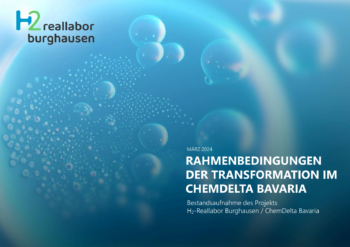How can the amount of greenhouse gas emissions saved through material efficiency projects be determined?
Many companies are implementing measures and projects in the area of climate protection and are committed to making our economy climate neutral. In addition to the emissions caused by a company directly, the upstream and downstream emissions are becoming increasingly important. These so-called “Scope 3” emissions are caused, for example, by the extraction, production, and transport of raw materials and account for a significant share of a company’s total emissions. These emissions can be reduced through resource efficiency methods such as using recycled materials or eliminating waste. Implementing such efficiency measures in companies can impact various phases of the life cycle, as shown in Figure 1. In addition to direct emissions, these also include emissions from the supply chain, as well as the use and disposal of products.

Since the implementation of a material efficiency measure can save emissions in different life cycle phases, balancing these emissions is often complicated and time-consuming. This is due to the fact that extensive data research and methodological knowledge are required, and the final results are not necessarily comparable with those of other companies. To simplify this process, the ESTEM project developed a simple standardized approach to calculating saved greenhouse gas emissions from material efficiency projects. With the help of the Excel-based ESTEM tool and the emission factors stored there, the ESTEM method can be applied quickly and easily in companies.
The project was commissioned by ministries from Baden-Württemberg, Bavaria, Hamburg, Hesse, and Rhineland-Palatinate under the organization of the project executing agency, the VDI Centre for Resource Efficiency (VDI-ZRE). The project was managed by the Steinbeis Transfer Centre for Marketing, Logistics, and Corporate Management at Pforzheim University under the direction of Prof. Dr. Mario Schmidt from the Institute for Industrial Ecology (INEC). In addition to FfE, the Technical University of Darmstadt, headed by Prof. Dr. Liselotte Schebek, and Systain Consulting GmbH in Hamburg were involved in the project.
The project developed the ESTEM tool, which is detailed in a guide. The underlying methodology is described in depth in the final report. The tool walks through 13 guiding questions about the various effects of measures step by step. For example, the tool asks how much material, waste, or energy is saved annually in the company. The materials or energy sources can be selected via a drop-down menu and are then automatically linked to the stored emission factors. Thus, the companies only need information on the amounts of materials, fuel or energy saved, and transport parameters. Only a few measures, such as recycling outside the company or extending the use phase, cannot be mapped with the tool since they require a separate life cycle analysis.
This is how we can support you in identifying, quantifying, or implementing material efficiency measures
Material efficiency measures are an effective lever for reducing Scope 3 emissions. We help you identify measures for your company. In doing so, we can build on previous projects in the field of resource efficiency and circular economy, such as “Resource View on the Energy Future” and “Circular-E-Wende”. If you would like to assess a material efficiency project in terms of GHG emissions saved, we would be happy to support you in the balancing process with the ESTEM methodology and tool. For further assessments in the field of material efficiency, GHG emissions, and life cycle assessments, we can draw on our many years of experience in the field of life cycle assessment.

